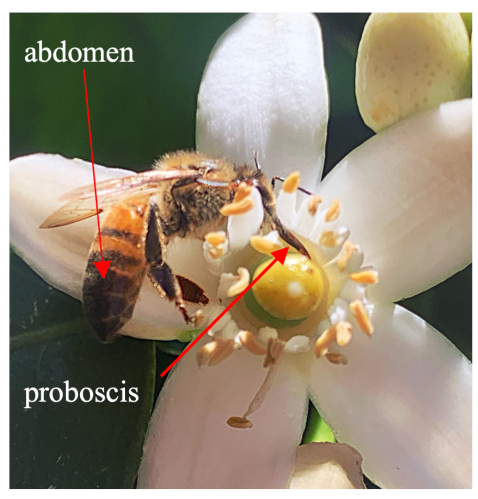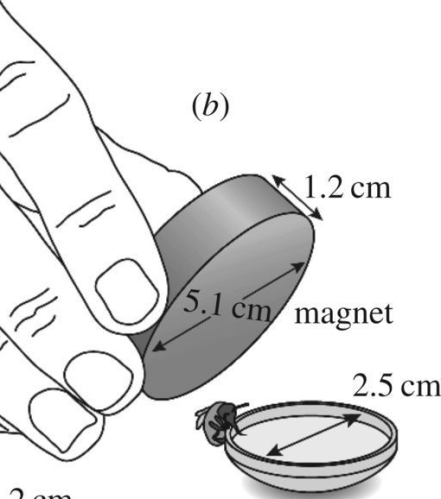Living in the 21st century, many of us are used to electronic gadgets that make our lives a little easier. I am still in awe that my smartphone can give me directions to anywhere in the world with just a press of a finger. Now, imagine the next technological advancement that could potentially replace our current smartphones. Maybe most of you, as I did, imagined that the future for smartphones might be a microchip-sized phone that could be implanted to work with your mind. Instead of having to press a button, all you’d have to do is think an action and the implanted phone would do the rest! It may seem crazy, but what if I told you that Mother Nature has already got us beat in that department?

In fact, various organisms, ranging from bacteria and algae to birds, fish, insects, and baby sea turtles, have a “biocompass” in their bodies that can detect magnetic fields. This sensing of magnetic fields is called magnetoreception, and there are two theories that describe how it might be possible. The first theory relies on the chemical use of nanosized magnetite particles (Fe3O4) within certain cells of the organism to act as magnetic receptors. The second theory, mostly relevant to migratory birds, speculates that magnetoreception works through a protein (cryptochrome) which allows the birds to see magnetic waves.
Of all the organisms theorized to use magnetoreception, I find honeybees (Apis mellifera) to be the most curious. I remember learning about Karl von Frisch’s Nobel Prize winning studies 1 in the 1970s focusing on honeybees’ “waggle dance,” a complex social communication tool the bees use to share information. Because of the importance of honeybee social communication, I wondered if the magnetite found in the honeybees could also play a role in their social behaviors.
History of Honeybee Magnetoreception Research
It wasn’t until the 1990s that researchers really established that honeybees have a magnetic sensory system consistent with the theory of magnetite-mediated magnetoreception.2 Later, a team from Canada was able to confirm that the honeybees’ magnetic biomaterial is localized specifically in their abdomen.3

Though scientists have developed methods to extract iron granules containing magnetite from honeybee abdomens,4,5 it’s been much harder to interpret how the magnetite functions within the honeybee to give them a sense of direction.

Can Honeybees Sense Magnetic Fields? Yes!
A team led by En-Chang Yang6 aimed to address this very question, and they did it by training honeybees to extend their proboscis when a magnetic field was applied. The honeybees learned to associate the magnetic stimulus with a reward of sugar and protruded their probiscis to get the sugar when the magnetic field was applied, showing that they could detect the magnetic field. The researchers observed that a small portion of the captured bees were not able to be trained, and explained that it might be because the bees were too young for magnetoreception.

Another part of this study also established that honeybees’ magnetic reception requires a specific nerve cord to relay signals between the bees’ abdomen and their brain for them to actually perceive the magnetic field.
Can strong human-made magnetic waves affect honeybees negatively? Maybe
As I continued to learn about honeybees’ magnetoreception, I wondered, “How do the commercial magnetic waves that humans use in our technology affect honeybees?” For example, could my cell phone be emanating strong enough magnetic fields to attract or confuse the honeybee? Is that why sometimes a random honeybee appears before me when I am on my phone? I dug a little more and found that experiments have shown that honeybees are able to sense magnetic field strengths around 260 µOe,4 which is much smaller than what’s produced by cell phones (about 60 Oe, or 60,000 µOe.7)
On the other extreme, the team from Canada reported that when trained honeybees were exposed to a magnetic field several thousand times stronger than the Earth’s magnetic field, which averages around 0.5 Oe, they no longer behaved as expected from their training. The illustration below describes the experiment: Imagine a bee is placed in the middle of a flat board (the zero mark in the middle of the x-axis) and at each end of the board is a water bowl. The bowl at one end has sugar (sucrose) water and the bowl at the other end has salt water. The researchers put a magnetic anomaly on the sucrose water side and the bees learn to associate the anomaly with the sucrose water so they almost always choose that side. Next, they split the trained bees into two groups: ones are magnetized for 5 seconds with a strong magnetic field of 2,200 Oe and the other is not. What they observed is that the trained bees exposed to the strong magnetic field no longer recognized the magnetic anomaly — nearly 50 percent of them went toward the salt water side, as shown with the bar marked (a) below. On the other hand, the bees that were not exposed to the strong magnetic field were able to still detect the magnetic anomaly and went toward the sucrose reward as they were originally trained. These results suggested that the magnetoreception of trained honeybees can be disrupted with a strong enough magnet.

Overall, whether my smartphone’s electromagnetic radiation has any deleterious effect on the honeybees is something that still needs further investigation.
Concerns that arose from writing this blog
Because of honeybee pollination, both wild and domestic, we are able to enjoy most of the variety of fruits, vegetables, and nuts we see in the grocery stores. I was astonished to find out that approximately a third of world’s food production is dependent on honeybees.8 Seeing how crucial honeybees are to agriculture and food security, I was disheartened to find out that since 2006, populations of honeybees in the western United States are declining. Aside from the deleterious ecological impact we are causing with current agricultural practices such as using unregulated pesticides or herbicides and habitat loss, I suspect that commercial electromagnetic pollution from various everyday appliances could also be contributing to the decline of honeybee populations.10,11
Although the evidence is still very inconclusive,12 perhaps the electromagnetic pollution could be connected to the phenomenon known as colony collapse disorder, which is when worker honeybees essentially abandon their beehives even when there is no apparent cause.9 As unintentional as we may be with disrupting honeybee’s magnetoreception, this could be a causal reason as to why honeybees are becoming lost in pursuit of food, water, and their homes. On the bright side, many organizations continue their efforts to stop the use of dangerous agrochemicals and advocate for bee-safe farming measures such as organic farming and restoration of wild habitat, which will hopefully help honeybee numbers rebound. Future research is also needed to decipher more about the mechanism and importance of magnetoreception in honeybees and how our presence in nature may affect our hard-working insect allies. This amazing nanoscale phenomenon may play a really big role in honeybee health.
References:
- Frisch, K. Decoding the Language of the Bee. Science. 1974, 185(4152), 663-668. http://www.jstor.org/stable/1738718.
- Kirschvink, J; Padmanabha, S; Boyce, C et al. Measurement of the threshold sensitivity of honeybees to weak, extremely low-frequency magnetic fields. The Journal of Experimental Biology. 1997, 200, 1363–1368. doi: 10.1242/jeb.200.9.1363
- Lambinet, V; Hayden, M; Reigl, K et al. Linking magnetite in the abdomen of honey bees to a magnetoreceptive function. Proceedings of the Royal Society B. 2017, 284(1851). doi: 10.1098/rspb.2016.2873.
- Hsu C-Y, Ko F-Y, Li C-W et al. Magnetoreception System in Honeybees (Apis mellifera). PLoS ONE. 2007 2(4), e395. doi: 10.1371/journal.pone.0000395.
- Shaw, J; Boyd, A; House, M et al. Magnetotactic Bacteria and Honey Bees: Model Systems for Characterising an Iron Oxide Mediated Magnetoreceptor. Microscopy and Microanalysis. 2015, 21, 85 – 86. doi: 10.1017/S1431927615001221
- Liang, C. H.; Chuang, C. L.; Jiang, J. A. et al. Magnetic Sensing through the Abdomen of the Honey bee. Scientific Reports. 2016, 6(23657). doi: 10.1038/srep23657
- Elert, G. Magnetic Field Near a Cellular Telephone. The Physics Factbook. 2003. https://hypertextbook.com/facts/2003/VietTran.shtml
- World Bee Day. The importance of bees. 2018. https://www.worldbeeday.org/en/about/the-importance-of-bees.html.
- Taye, R; Deka, M; Rahman, A et al. Effect of electromagnetic radiation of cell phone tower on foraging behaviour of Asiatic honey bee, Apis cerana F. (Hymenoptera: Apidae). Journal of Entomology and Zoology Studies. 2017, 5(3), 1527-1529. E-ISSN: 2320-7078
- Favre, D. Mobile phone-induced honeybee worker piping. Apidologie. 2011, 42. 270–279. doi: 10.1007/s13592-011-0016-x
- Lupi et al. Effects of Pesticides and Electromagnetic Fields on Honeybees: A Field Study Using Biomarkers. International Journal of Environmental Research. 2020, 14, 107–122. doi: 10.1007/s41742-019-00242-4
- Vanbergen, A., Potts, S., Vian, A. et al. Risk to pollinators from anthropogenic electro-magnetic radiation (EMR): Evidence and knowledge gaps. Science of the Total Environment. 2019, 695: 133833. doi: 10.1016/j.scitotenv.2019.133833
